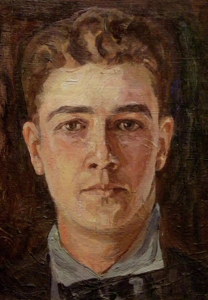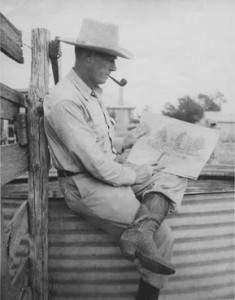

Biography
Harold Dow Bugbee was born in 1900 in Lexington, MA to parents Charles H. Bugbee and and Grace Louise Dow Bugbee. Around the time of his marriage, Charles had inherited some real estate at the death of his parents. He and his wife relocated from Boston to Lexington, where Charles operated a farm and was active on the town council. Both of Harold's parents were familiar with the arts: Charles had trained as a musician and played clarinet with the Boston Grand Opera, and Grace had studied the fine arts. A cattleman relative of Charles's advised the couple to move to Texas, which they did in 1915, buying a cattle ranch in Clarendon, TX.
Harold graduated from Clarendon High School in 1917. Enchanted with ranch life, Bugbee conceived the idea of preserving aspects of western culture through art. He enrolled at Texas A&M in College Station, TX in 1918 to study architectural drawing. He visited Taos, NM in the summer of 1919, hoping to study with William Herbert Dunton, one of the founders of the Taos Society of Artists. He didn't study with Dunton at that time, but another Taos founder, Bert Geer Phillips, steered him to the Cumming School of Art in Des Moines, IA. The School was operated by the portrait painter Charles Atherton Cumming, who also established the art department at the University of Iowa in Iowa City. Bugbee remained with Cumming until 1921.
Bugbee spent the summers of 1922-1930 in Taos, working with the older artist Dunton and others including Leon Gaspard, Frank Hoffman, and Ralph Meyers. He often camped in the Rockies with Meyers or Dunton. Back in West Texas, Bugbee found patrons such as the Amarillo mayor and hotel owner Ernest O. Thompson, who commissioned Bugbee to paint 11 murals for the Tascosa Room of the Herring Hotel. He painted an additional 14 murals for the Longhorn Room of the Amarillo Hotel.
In addition to his mural painting, Bugbee sold easel paintings to local ranchers and to collectors of Western art. He sold his Christmas card designs worldwide, and he exhibited his work in galleries in Denver, Chicago, Kansas City, and New York. From 1933-1950 Bugbee provided pen-and-ink sketches to illustrate books and magazines, including a long association with western historian J. Evetts Haley.
In 1934 Bugbee was commissioned by the Public Works of Art Project to create 5 murals for the Museum of the Panhandle-Plains Historical Society, completed in 1940. Bugbee was drafted in 1942, but was discharged for health reasons. He painted 3 murals for the Amarillo Army Air Field in 1943, two of which are now in the National Museum of American Art.
From 1951-1963 Bugbee served as art curator for the Panhandle-Plains Historical Society, eventually completing 22 murals for the Society's Museum. His trail-driving scene of Texas cattleman R. B. Masterson hangs in the Texas Hall of State in Dallas, TX. And Bugbee's design is featured on the 1931 Trail Driver's Monument in the ghost town of Doans, TX.
Bugbee donated 230 works of art to the Museum of the Panhandle-Plains Historical Society. He was married twice, first in 1935 to Katherine Patrick and then in 1961 to Olive Freda Vandruff, who was also an artist. Upon her death in 2003, her estate was left to the Panhandle-Plains Historical Society Museum.


Critical Analysis
Bugbee's ambition was to use his painting to preserve the culture of the Southern Plains and the Texas Panhandle. He was eminently successful in meeting this goal, as the massive collection of the Panhandle-Plains Historical Society will attest. Bugbee was inspired by the work of Charles M. Russell, who painted the Northern Plains, and Bugbee can rightly be viewed as Russell's counterpart for the Southern Plains.
Bugbee's most famous mural, "The Cattleman," has a bit of the feel of an illustration writ large. The horsemen and the cattle stare directly out at the viewer. All the figures - and even the trees and hills in the background - are heavily outlined, as if from a pen-and-ink drawing. The effect is one of intimacy, bringing the large painting down to a more accessible scale.
Murals
- Canyon, Texas - Panhandle-Plains Historical Museum: Hide Hunters
- Canyon, Texas - Panhandle-Plains Historical Museum: Hunting Buffalo
- Canyon, Texas - Panhandle-Plains Historical Museum: Ranch Headquarters
- Canyon, Texas - Panhandle-Plains Historical Museum: The Cattleman
- Canyon, Texas - Panhandle-Plains Historical Museum: Working Cattle on the Open Range
References
- Bugbee, H.D. (1900-1963) (Encyclopedia of the Great Plains).
- Michael R. Grauer, Carprock Chronicles: Artist Harold Dow Bugbee left his mark on West Texas, Lubbock Avalanche Journal May 1 (2020).
- H.D. Bugbee (Field Guide to Wild American Pulp Artists).
- Harold Bugbee (Foltz Fine Art).
- Harold Dow Bugbee (Wikipedia).
- Texoso, Harold Dow Bugbee, Texas History Notebook February 2 (2023).